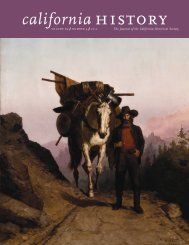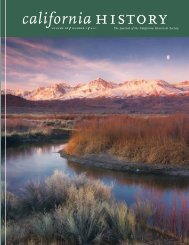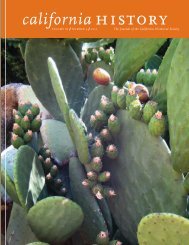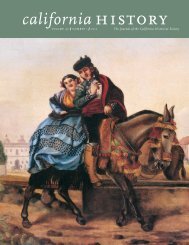california history - California Historical Society
california history - California Historical Society
california history - California Historical Society
You also want an ePaper? Increase the reach of your titles
YUMPU automatically turns print PDFs into web optimized ePapers that Google loves.
even on existing dorms due to the high cost ofmaintenance and low usage, had ranked Berkeleyas the lowest of all nine UC campuses in priorityfor new housing. Nevertheless, in a supremetouch of irony, administrators proceeded with aplan to demolish the low-cost off-campus housingpreferred by students in favor of high-risedormitories. As for the soccer field, ProfessorSim Van der Ryn, a member of the College ofArchitecture and chairman of the Chancellor’sAdvisory Committee on Housing and the Environment,accused Heyns of having “patentlyinvented” the “desperate need” for a soccer fieldto rationalize milking funds from the Regents.The campus’s existing soccer fields were notused to their full capability; even the conservativeNational Review conceded that soccer was “a sportwhich at Berkeley ranks right up there in popularitywith cock-fighting.” 6Van der Ryn alluded to other factors behind theuniversity’s haste to implement the plan, suggestingthat Cheit wanted to “clean up that areaand get rid of the people living there who are athreat to the stability of the University.” Indeed,the resolution adopted by the Regents specificallyaddressed the undesirability of Telegraph Avenueresidents: “The area has been the scene of hippieconcentration and rising crime.” The NationalReview agreed, stating that university administratorshad endeavored “to check the growth of thealien culture which has put down roots alongTelegraph Avenue” by seeking “to deny it growingspace.” 7After completing the lot’s purchase throughthe exercise of eminent domain, the universitydemolished houses standing on the propertybetween November 1967 and June 1968, uprootingstudent renters who were frequently inthe midst of final examinations. But, as it hada decade earlier, campus leaders took a sluggishapproach to developing the newly acquiredproperty.At this point, Van der Ryn and the advisory committeesuggested that the university set asidesome of the land for “people on the street tomake a place of their own, and to take some ofthe pressure off a crowded and tense TelegraphAvenue.” The administration, however, ignoredthis advice, and the site became an undevelopedvacant lot. Students used it for parking wheneverrainfall did not create too much mud. Meanwhile,the university insisted that it lacked thenecessary funding for construction of the projectedsoccer field. In April 1969, the founders ofPeople’s Park stepped into the void, setting thestage for a conflict whose repercussions are felttoday, more than forty years later, in the continuedstruggle over interpretations of public space. 8Act I: Creating the ParkThe concept of constructing a communitycontrolled,user-developed park was popularizedby a local merchant, Mike Delacour, owner of theRed Square dress shop. From 1956 to 1964, Delacourhad worked for General Dynamics, climbinghis way up the corporate ladder from mechanic’shelper to research and mechanical technicianand working on missile installations at variousAir Force bases. He later recalled a comfortablemiddle-class existence along with his wife andthree children in the San Diego suburb of Santee:“It was the American dream, living together butnot knowing your neighbors. I only got to know aneighbor when our wives had a fight going oversome dumb thing. It was worse than a ghetto—there was no community.” 9Following a divorce, Delacour rejected theregimentation that he felt General Dynamicsrequired, quit his job in 1964, and spent the nextyear traveling around Europe on a Eurailpass.Reports he had heard about Berkeley appealedto his new spirit of freedom and adventure, andso upon returning to the States in 1965, it wasnot Santee but Berkeley, and its radical politicalscene, to which he gravitated. 101 <strong>California</strong> History • volume 88 number 1 2010









